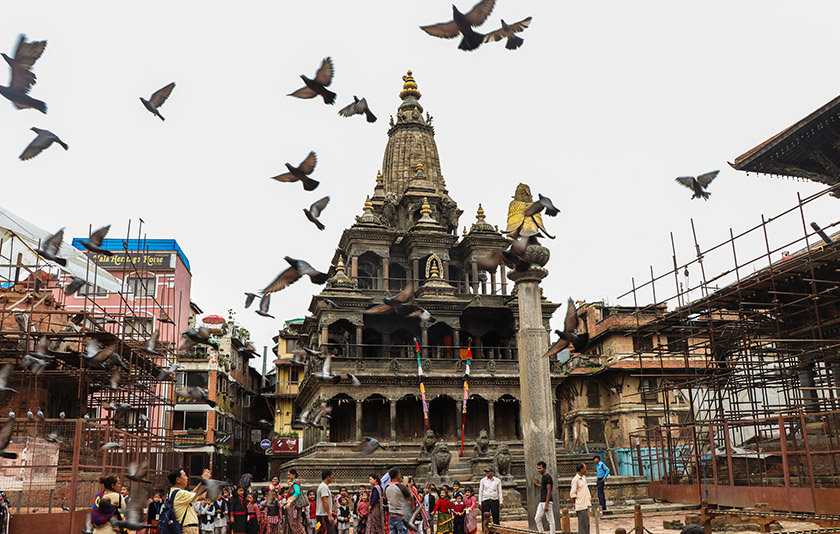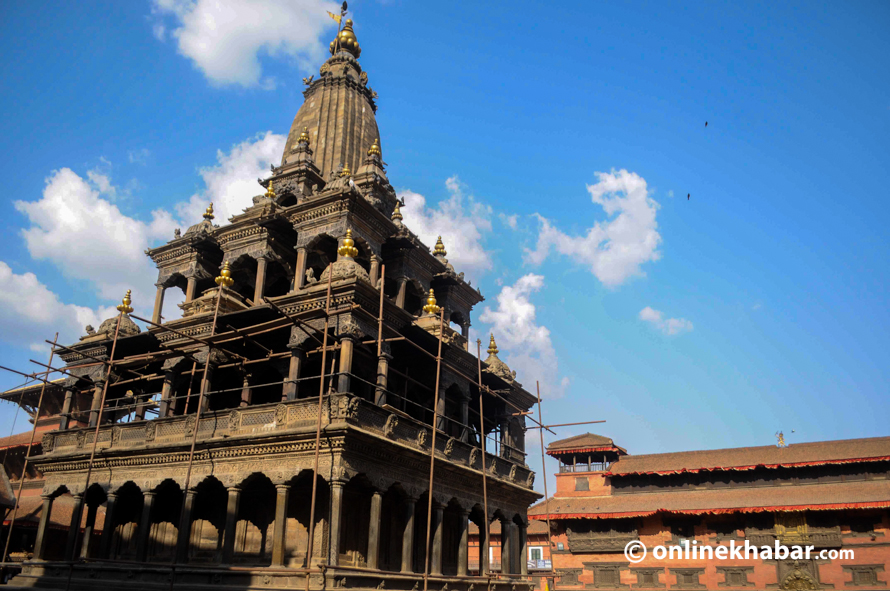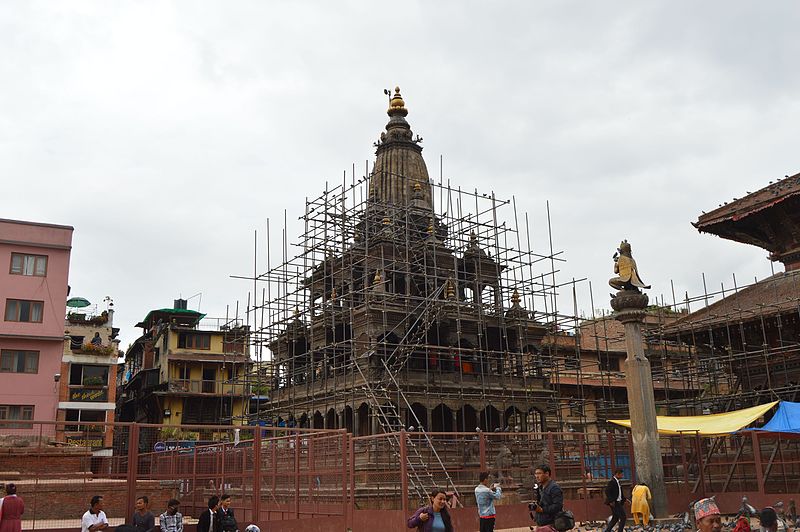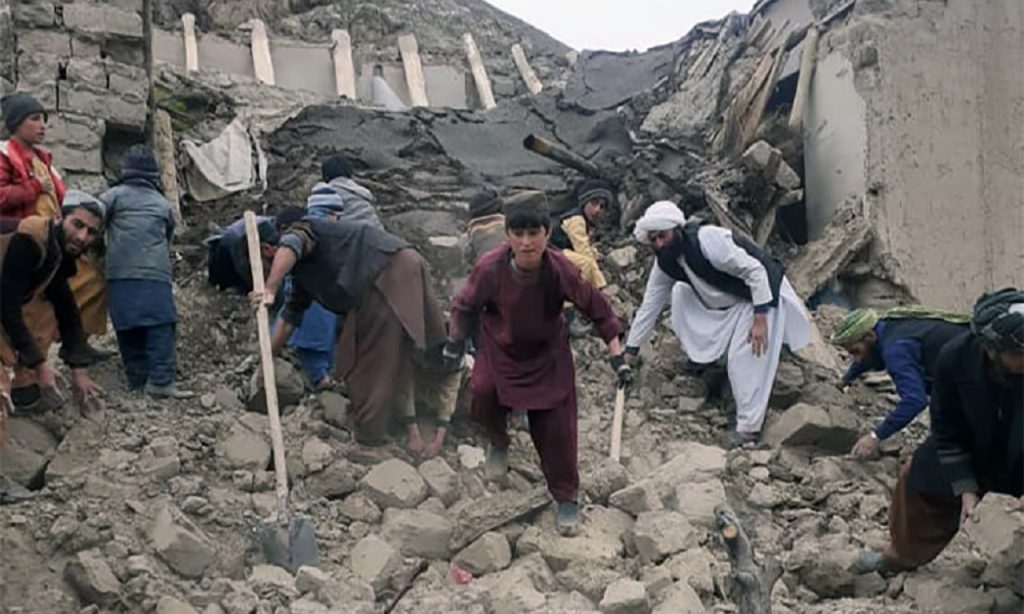
The Patan Krishna Mandir, built in 1637 by Siddhi Narsing Malla, has a lot of cultural significance. Built-in the Shikhara style and constructed using carved stone, instead of the usual brick and timber, this temple is one of the oldest stone temples in Nepal.
While many pagoda style temples were reduced to rubble, in the past, the Krishna Mandir had not been damaged until the quake in 2015. The temple incurred a lot of structural damage–especially the top two floors that housed Shiva and Buddha. It was closed for visitors.
“The floor above the Krishna shrine was the worst hit by the earthquake,” explains Dr Rohit Ranjitkar, who is the Program Director of Kathmandu Valley Preservation Trust (KVPT), an organisation working on cultural preservation in Patan. “The pillars were damaged significantly along with the cornerstones which were supporting the floors above.”
To make sure the whole structure doesn’t crumble, KVPT, after studying the temple, decided to support the building by propping it. “Many approached us telling us to demolish the building and build it again. But doing that would make this 17th-century temple new. So we decided to restore the traditional way,” he adds.
During the examination of the temple, KVPT officials realised that they had to tread carefully because the soft cornerstones had given up during the 7.8 magnitude earthquake. “The one on the north-west corner was in such a bad state it didn’t even exist.”

Their first measure was to assemble the pieces which had to be extracted carefully. “The blocks were quite big–some of them more than 2 feet long. Removing them was quite hard,” he explains.
After removing the cornerstones, engineers at KVPT decided to place one cornerstone on the building at a time. “It was an excellent advice because as the stones were bearing the load of the building, we needed to give lime mortar time to settle, which would guarantee its longevity.”
Each cornerstone took two-three weeks to settle. “The cornerstones were weakened due to the 1934 earthquake. The people then didn’t do enough after that earthquake. This is the reason why the temple suffered structural damage and to avoid a repeat of such incidents, we were ready to be patient,” he adds.
While many conservation works are done by contractors, KVPT doesn’t believe in working with them–mainly because they want to do things their own way. “We have our own team of engineers who assess the building and then come up with solutions to rebuild them.”
“Giving it to the lowest bidder will compromise the integrity of work done. This is the reason we work with local artisans of Patan and Bhaktapur who know what we are trying to achieve,” he shares.
One artisan is Surya Bahadur Ranjitkar who has been working as a sculptor with KVPT for the past nine years. “I feel glad to have been given the chance to work in this building,” he adds. “It’s special because even my father who taught me this worked here as a mason before.”
His role in the restoration: carve stones and give inputs to the engineers to make sure the building doesn’t fall off. “The Sikhara style buildings have stone clips on the corners. It is similar to the locks in the wooden temples in the area and that clip had to be of a particular shape that is where I gave my inputs,” he shares.

After the cornerstones were settled Surya Bahadur then started his work of giving patterns to the stones. The stone carvings along the beam above the first and second-floor pillar are most notable as they narrate the events of the Mahabharata and Ramayana.
“The old patterns were very complex but having worked as a sculptor for as long as I didn’t have a hard time. I took my time and feel have done a good job,” he shares.
Working on a pagoda building is different from working on a sikhara building. “Rock work is not easy, it takes time and we have to be extra careful if we are to repair it properly,” they say.
After 18 months, the temple is finally restored thanks to KVPT who spent Rs. 5.7 million on the project. This year, the temple welcomed pilgrims for the first time in three years. “We had to take our time. This is an important building here in Patan and we don’t want to risk human lives,” shares Dr Ranjitkar who adds that the funding for the temple came from the Gerda Henkel Foundation and the Japanese Embassy.
“The foreign aid we received was quite helpful. It helped rebuild this Durbar Square in a way it was before the earthquake. Yes, most of the temples will be new, but at least the people will relate to it,” he shares.





















